

Compact Muon Solenoid
LHC, CERN
| CMS-PAS-SMP-13-008 | ||
| Search for anomalous couplings in the production of WW and WZ pairs decaying semileptonically in proton-proton collisions at $\sqrt{s}= $ 8 TeV | ||
| CMS Collaboration | ||
| December 2016 | ||
| Abstract: A search for new physics is reported, in which the new physics appears in anomalous couplings of triple gauge boson vertices involving WW or WZ diboson production from proton-proton collisions. The search is performed on a sample of events containing a W boson that decays leptonically and a W or Z boson where the decay products are merged into a single jet. The data sample, collected at $\sqrt{s} = $ 8 TeV with the CMS detector at the LHC, corresponds to an integrated luminosity of 19 fb$^{-1}$. No evidence for anomalous triple gauge couplings is found and the following 95% confidence limits are set on their magnitudes: $\lambda$($ [-0.011, 0.011]$), $\Delta{\kappa_\gamma}$($ [-0.044, 0.063]$), and $\Delta{G_1^Z}$($ [-0.0087, 0.024]$). These limits are also translated into their effective field theory equivalents: $c_{WWW}/\Lambda^2$($ [-2.7, 2.7] \mathrm{TeV}^{-2}$), $c_B/\Lambda^2$($ [-14, 17] \mathrm{TeV}^{-2}$), and $c_W/\Lambda^2$($ [-2.0, 5.7] \mathrm{TeV}^{-2}$). | ||
|
Links:
CDS record (PDF) ;
inSPIRE record ;
CADI line (restricted) ;
These preliminary results are superseded in this paper, PLB 772 (2017) 21. The superseded preliminary plots can be found here. |
||
| Figures | |

png pdf |
Figure 1:
Distributions of the merged jet invariant mass for muons, (top) and electrons (bottom) with the projections of the relevant components overlaid. The merged jet invariant mass is plotted for all events (left), after subtraction of all components except the diboson (center) and subsequent normalized residual or pull distributions: $(\text {data} - \text {fit})/(\text {fituncertainty})$ (right). The error bars represent statistical uncertainties. The dashed vertical lines mark the signal region of $70 |
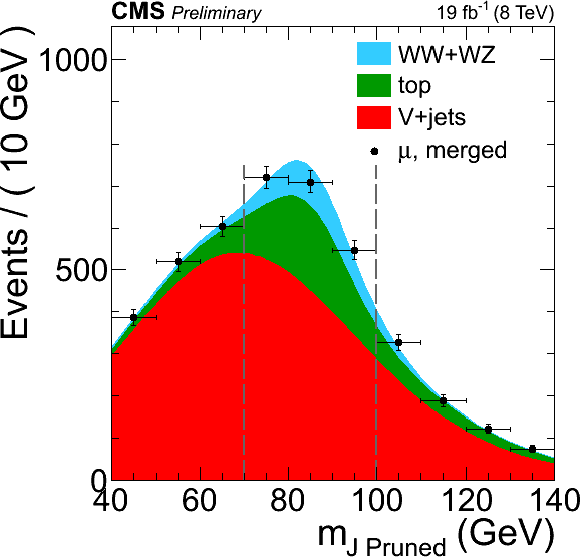
png |
Figure 1-a:
Distributions of the merged jet invariant mass for muons, (top) and electrons (bottom) with the projections of the relevant components overlaid. The merged jet invariant mass is plotted for all events (left), after subtraction of all components except the diboson (center) and subsequent normalized residual or pull distributions: $(\text {data} - \text {fit})/(\text {fituncertainty})$ (right). The error bars represent statistical uncertainties. The dashed vertical lines mark the signal region of $70 |
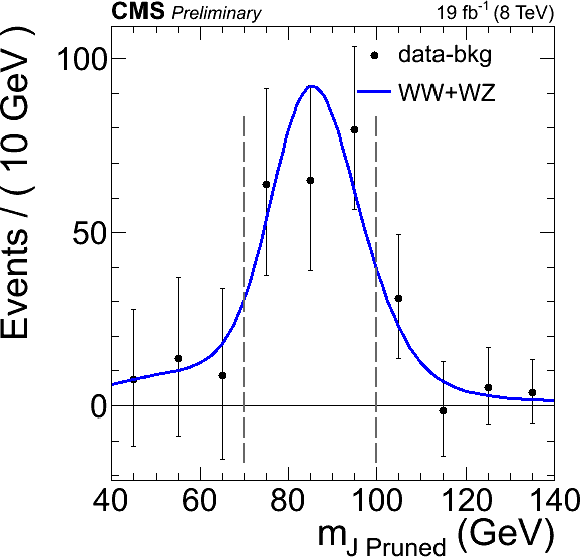
png |
Figure 1-b:
Distributions of the merged jet invariant mass for muons, (top) and electrons (bottom) with the projections of the relevant components overlaid. The merged jet invariant mass is plotted for all events (left), after subtraction of all components except the diboson (center) and subsequent normalized residual or pull distributions: $(\text {data} - \text {fit})/(\text {fituncertainty})$ (right). The error bars represent statistical uncertainties. The dashed vertical lines mark the signal region of $70 |

png |
Figure 1-c:
Distributions of the merged jet invariant mass for muons, (top) and electrons (bottom) with the projections of the relevant components overlaid. The merged jet invariant mass is plotted for all events (left), after subtraction of all components except the diboson (center) and subsequent normalized residual or pull distributions: $(\text {data} - \text {fit})/(\text {fituncertainty})$ (right). The error bars represent statistical uncertainties. The dashed vertical lines mark the signal region of $70 |

png |
Figure 1-d:
Distributions of the merged jet invariant mass for muons, (top) and electrons (bottom) with the projections of the relevant components overlaid. The merged jet invariant mass is plotted for all events (left), after subtraction of all components except the diboson (center) and subsequent normalized residual or pull distributions: $(\text {data} - \text {fit})/(\text {fituncertainty})$ (right). The error bars represent statistical uncertainties. The dashed vertical lines mark the signal region of $70 |
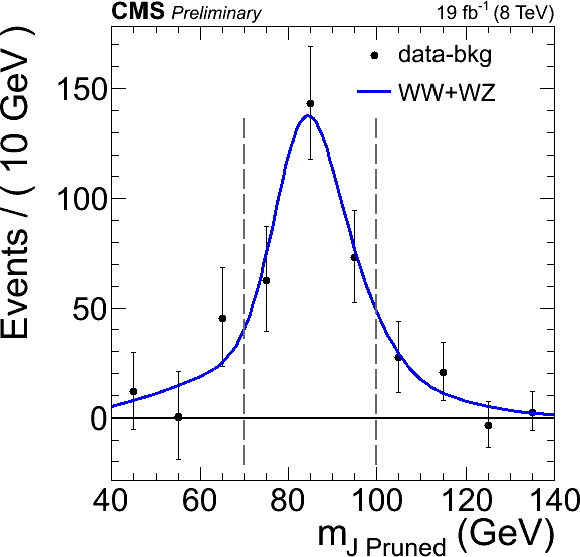
png |
Figure 1-e:
Distributions of the merged jet invariant mass for muons, (top) and electrons (bottom) with the projections of the relevant components overlaid. The merged jet invariant mass is plotted for all events (left), after subtraction of all components except the diboson (center) and subsequent normalized residual or pull distributions: $(\text {data} - \text {fit})/(\text {fituncertainty})$ (right). The error bars represent statistical uncertainties. The dashed vertical lines mark the signal region of $70 |
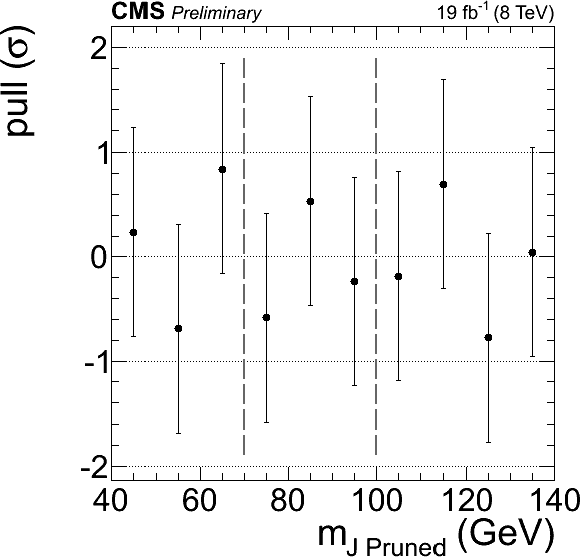
png |
Figure 1-f:
Distributions of the merged jet invariant mass for muons, (top) and electrons (bottom) with the projections of the relevant components overlaid. The merged jet invariant mass is plotted for all events (left), after subtraction of all components except the diboson (center) and subsequent normalized residual or pull distributions: $(\text {data} - \text {fit})/(\text {fituncertainty})$ (right). The error bars represent statistical uncertainties. The dashed vertical lines mark the signal region of $70 |
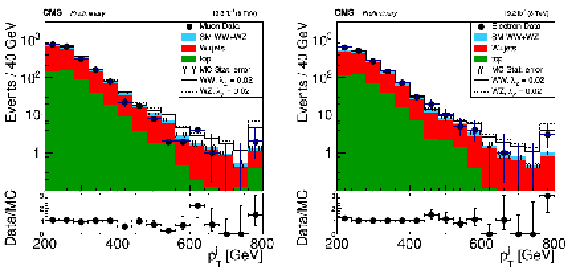
png pdf |
Figure 2:
V$_{had}$ $ {p_{\mathrm {T}}} $ distributions for the muon (left) and electron (right) merged jet channels after full selection and with the requirement $70 GeV < m_{J} < 100 GeV $. The MC errors are purely statistical. The stacked histogram shapes are taken from simulation. They are normalized according to the fit to the observed spectrum in data, with the exception of the SM WV, which is normalized to the theoretical prediction. Below we show the data/MC ratio. The last bin includes the overflow. |
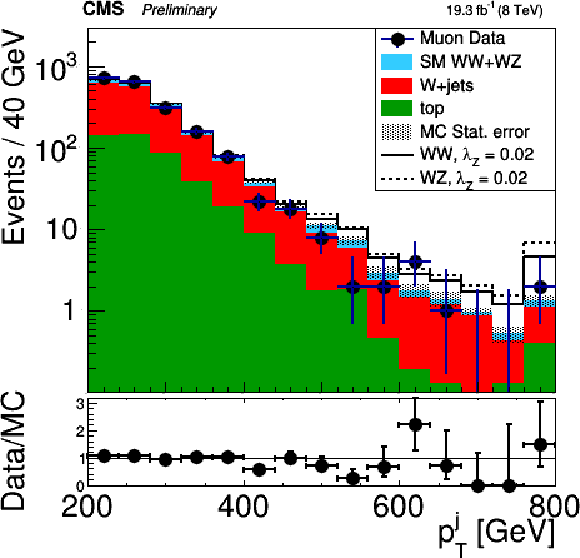
png |
Figure 2-a:
V$_{had}$ $ {p_{\mathrm {T}}} $ distributions for the muon (left) and electron (right) merged jet channels after full selection and with the requirement $70 GeV < m_{J} < 100 GeV $. The MC errors are purely statistical. The stacked histogram shapes are taken from simulation. They are normalized according to the fit to the observed spectrum in data, with the exception of the SM WV, which is normalized to the theoretical prediction. Below we show the data/MC ratio. The last bin includes the overflow. |
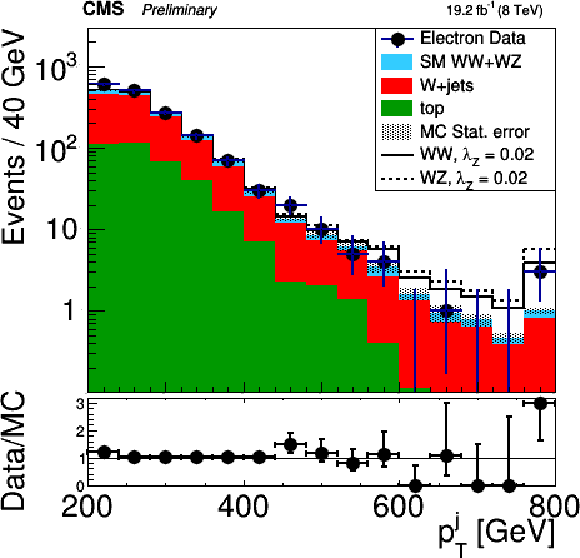
png |
Figure 2-b:
V$_{had}$ $ {p_{\mathrm {T}}} $ distributions for the muon (left) and electron (right) merged jet channels after full selection and with the requirement $70 GeV < m_{J} < 100 GeV $. The MC errors are purely statistical. The stacked histogram shapes are taken from simulation. They are normalized according to the fit to the observed spectrum in data, with the exception of the SM WV, which is normalized to the theoretical prediction. Below we show the data/MC ratio. The last bin includes the overflow. |
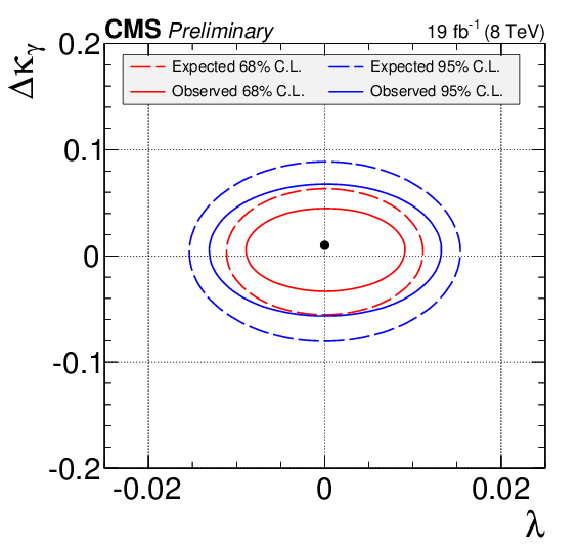
png pdf |
Figure 3-a:
Above are depicted the 68% and 95% CL observed and expected exclusion contours for three pairwise combinations of the anomalous triple gauge coupling parameters in the HISZ parametrization (top) and in the effective field theory formulation (bottom). |
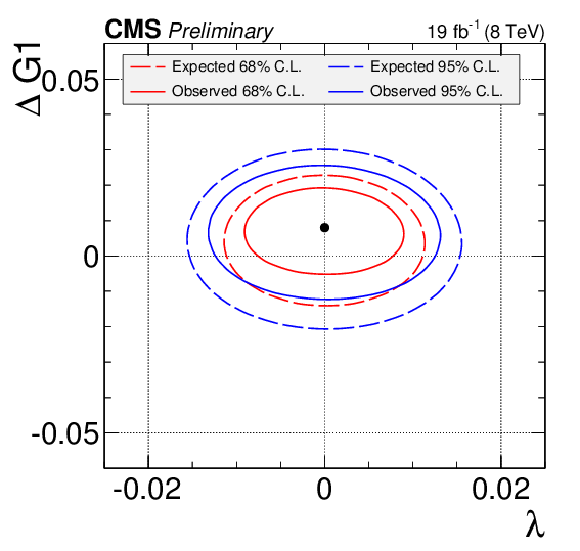
png pdf |
Figure 3-b:
Above are depicted the 68% and 95% CL observed and expected exclusion contours for three pairwise combinations of the anomalous triple gauge coupling parameters in the HISZ parametrization (top) and in the effective field theory formulation (bottom). |
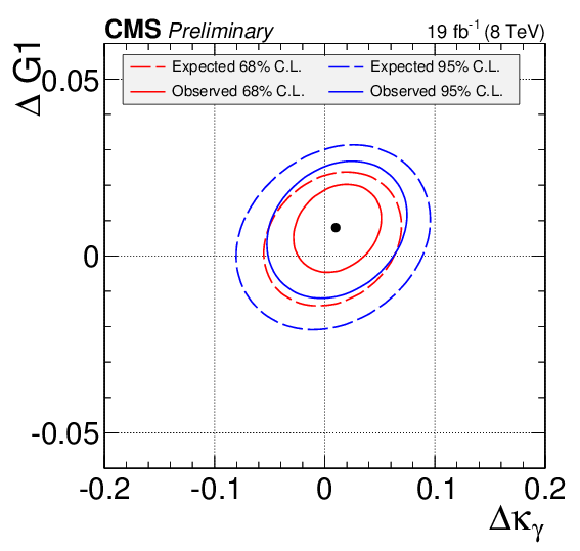
png pdf |
Figure 3-c:
Above are depicted the 68% and 95% CL observed and expected exclusion contours for three pairwise combinations of the anomalous triple gauge coupling parameters in the HISZ parametrization (top) and in the effective field theory formulation (bottom). |

png pdf |
Figure 3-d:
Above are depicted the 68% and 95% CL observed and expected exclusion contours for three pairwise combinations of the anomalous triple gauge coupling parameters in the HISZ parametrization (top) and in the effective field theory formulation (bottom). |
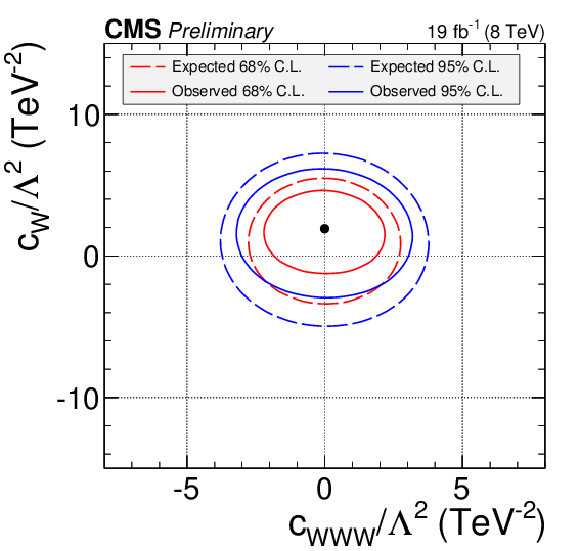
png pdf |
Figure 3-e:
Above are depicted the 68% and 95% CL observed and expected exclusion contours for three pairwise combinations of the anomalous triple gauge coupling parameters in the HISZ parametrization (top) and in the effective field theory formulation (bottom). |

png pdf |
Figure 3-f:
Above are depicted the 68% and 95% CL observed and expected exclusion contours for three pairwise combinations of the anomalous triple gauge coupling parameters in the HISZ parametrization (top) and in the effective field theory formulation (bottom). |
| Tables | |
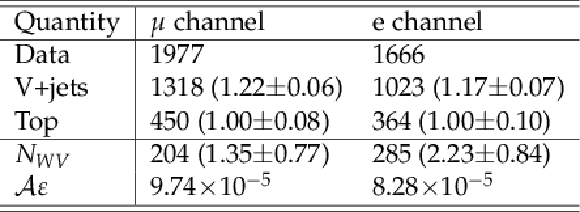
png pdf |
Table 1:
Observed and expected event yields and associated fractions (in parentheses) with respect to the prefit values extracted in the signal region ($70 |

png pdf |
Table 2:
Summary of one-dimensional limits placed on each coupling parameter. Each number pair represents the observed 95% confidence interval for that parameter. |
| Summary |
| References | ||||
| 1 | L. J. Dixon, Z. Kunszt, and A. Signer | Vector boson pair production in hadronic collisions at order $ \alpha_s $ : lepton correlations and anomalous couplings | PRD 60 (1999) 114037 | hep-ph/9907305 |
| 2 | K. Hagiwara, S. Ishihara, R. Szalapski, and D. Zeppenfeld | Low energy effects of new interactions in the electroweak boson sector | PRD 48 (1993) 2182 | |
| 3 | C. Degrande et al. | Effective Field Theory: A Modern Approach to Anomalous Couplings | Annals Phys. 335 (2013) 21--32 | 1205.4231 |
| 4 | CMS Collaboration | Measurement of the sum of $ W W $ and $ WZ $ production with $ W+ $dijet events in $ pp $ collisions at $ \sqrt{s}=7 $ TeV | EPJC 73 (2013) 2283 | CMS-SMP-12-015 1210.7544 |
| 5 | ATLAS Collaboration | Measurement of the $ WW+WZ $ cross section and limits on anomalous triple gauge couplings using final states with one lepton, missing transverse momentum, and two jets with the ATLAS detector at $ \sqrt{\rm{s}} = 7 $ TeV | JHEP 01 (2015) 049 | 1410.7238 |
| 6 | CMS Collaboration | Measurement of the $ \text{W}^+\text{W}^- $ cross section in pp collisions at $ \sqrt{s} = $ 8 TeV and limits on anomalous gauge couplings | EPJC 76 (2016), no. 7, 401 | CMS-SMP-14-016 1507.03268 |
| 7 | ATLAS Collaboration | Measurement of total and differential $ W^+W^- $ production cross sections in proton-proton collisions at $ \sqrt{s}= $ 8 TeV with the ATLAS detector and limits on anomalous triple-gauge-boson couplings | JHEP 09 (2016) 029 | 1603.01702 |
| 8 | CMS Collaboration | The CMS experiment at the CERN LHC | JINST 3 (2008) S08004 | |
| 9 | J. Alwall et al. | MadGraph 5: going beyond | JHEP 06 (2011) 128 | 1106.0522 |
| 10 | P. Nason | A New method for combining NLO QCD with shower Monte Carlo algorithms | JHEP 11 (2004) 040 | hep-ph/0409146 |
| 11 | S. Frixione, P. Nason, and C. Oleari | Matching NLO QCD computations with Parton Shower simulations: the POWHEG method | JHEP 11 (2007) 070 | 0709.2092 |
| 12 | S. Alioli, P. Nason, C. Oleari, and E. Re | A general framework for implementing NLO calculations in shower Monte Carlo programs: the POWHEG BOX | JHEP 06 (2010) 043 | 1002.2581 |
| 13 | S. Frixione, P. Nason, and G. Ridolfi | A Positive-weight next-to-leading-order Monte Carlo for heavy flavour hadroproduction | JHEP 09 (2007) 126 | 0707.3088 |
| 14 | S. Alioli, P. Nason, C. Oleari, and E. Re | NLO single-top production matched with shower in POWHEG: s- and t-channel contributions | JHEP 09 (2009) 111 | 0907.4076 |
| 15 | J. Alwall et al. | The automated computation of tree-level and next-to-leading order differential cross sections, and their matching to parton shower simulations | JHEP 07 (2014) 079 | 1405.0301 |
| 16 | T. Sj\"ostrand, S. Mrenna, and P. Skands | PYTHIA 6.4 Physics and Manual | JHEP 05 (2006) 026 | hep-ph/0603175 |
| 17 | CMS Collaboration | Measurement of the underlying event activity at the LHC with $ \sqrt{s}= 7 $ TeV and comparison with $ \sqrt{s} = 0.9 $ TeV | JHEP 09 (2011) 109 | CMS-QCD-10-010 1107.0330 |
| 18 | J. Pumplin et al. | New generation of parton distributions with uncertainties from global QCD analysis | JHEP 07 (2002) 012 | hep-ph/0201195 |
| 19 | GEANT4 Collaboration | GEANT4---a simulation toolkit | NIMA 506 (2003) 250 | |
| 20 | CMS Collaboration | Particle-Flow Event Reconstruction in CMS and Performance for Jets, Taus, and MET | Technical Report CMS-PAS-PFT-09-001, CERN, Geneva, Apr | |
| 21 | CMS Collaboration | Commissioning of the Particle-flow Event Reconstruction with the first LHC collisions recorded in the CMS detector | Technical Report CMS-PAS-PFT-10-001, CERN, Geneva | |
| 22 | CMS Collaboration | The performance of the CMS muon detector in proton-proton collisions at sqrt(s) = 7 TeV at the LHC | JINST 8 (2013) P11002 | CMS-MUO-11-001 1306.6905 |
| 23 | CMS Collaboration | Performance of Electron Reconstruction and Selection with the CMS Detector in Proton-Proton Collisions at $ \sqrt{s} $ = 8 TeV | JINST 10 (2015), no. 06, P06005 | CMS-EGM-13-001 1502.02701 |
| 24 | M. Cacciari, G. P. Salam, and G. Soyez | The anti-$ k_t $ jet clustering algorithm | JHEP 04 (2008) 063 | 0802.1189 |
| 25 | M. Cacciari, G. P. Salam, and G. Soyez | FastJet User Manual | EPJC 72 (2012) 1896 | 1111.6097 |
| 26 | Y. L. Dokshitzer, G. Leder, S. Moretti, and B. Webber | Better jet clustering algorithms | JHEP 08 (1997) 001 | hep-ph/9707323 |
| 27 | CMS Collaboration | Identification of b-quark jets with the CMS experiment | JINST 8 (2013) P04013 | CMS-BTV-12-001 1211.4462 |
| 28 | CMS Collaboration | Studies of jet mass in dijet and W/Z+jet events | JHEP 05 (2013) 090 | CMS-SMP-12-019 1303.4811 |
| 29 | S. D. Ellis, C. K. Vermilion, and J. R. Walsh | Recombination algorithms and jet substructure: pruning as a tool for heavy particle searches | PRD 81 (2010) 094023 | 0912.0033 |
| 30 | J. Thaler and K. Van Tilburg | Identifying boosted objects with N-subjettiness | JHEP 03 (2011) 015 | 1011.2268 |
| 31 | CMS Collaboration | Search for massive resonances decaying into pairs of boosted bosons in semi-leptonic final states at $ \sqrt{s} = $ 8 TeV | JHEP 08 (2014) 174 | CMS-EXO-13-009 1405.3447 |
| 32 | Particle Data Group | The review of particle physics | CPC 38 (2014) 090001 | |
| 33 | CMS Collaboration | Search for a Higgs Boson in the Mass Range from 145 to 1000 GeV Decaying to a Pair of W or Z Bosons | JHEP 10 (2015) 144 | CMS-HIG-13-031 1504.00936 |
| 34 | J. M. Campbell and R. K. Ellis | MCFM for the Tevatron and the LHC | NPPS 205--206 (2010) 10 | 1007.3492 |
| 35 | CMS Collaboration | CMS Luminosity Based on Pixel Cluster Counting - Summer 2013 Update | ||
| 36 | ATLAS and CMS Collaborations, LHC Higgs Combination Group | Procedure for the LHC Higgs boson search combination in Summer 2011 | Technical Report ATL-PHYS-PUB 2011-11, CMS-NOTE 2011-005 | |
| 37 | DELPHI, OPAL, LEP Electroweak, ALEPH, L3 Collaboration | Electroweak measurements in electron-positron collisions at W-boson-pair energies at LEP | PR 532 (2013) 119 | 1302.3415 |

|
Compact Muon Solenoid LHC, CERN |

|

|

|

|

|

|